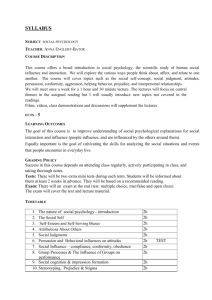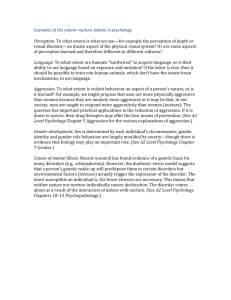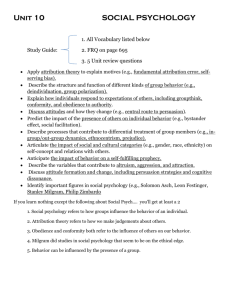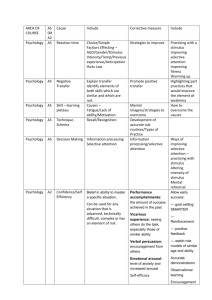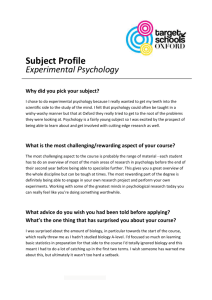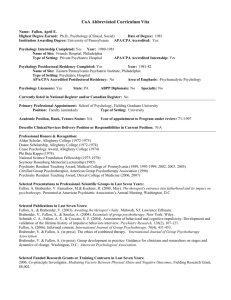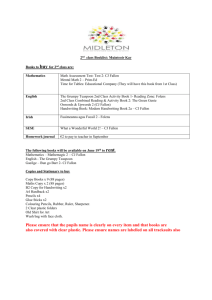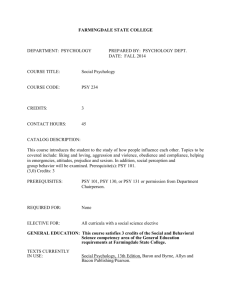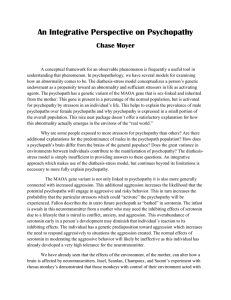Psychology Book Club Book Selection
advertisement
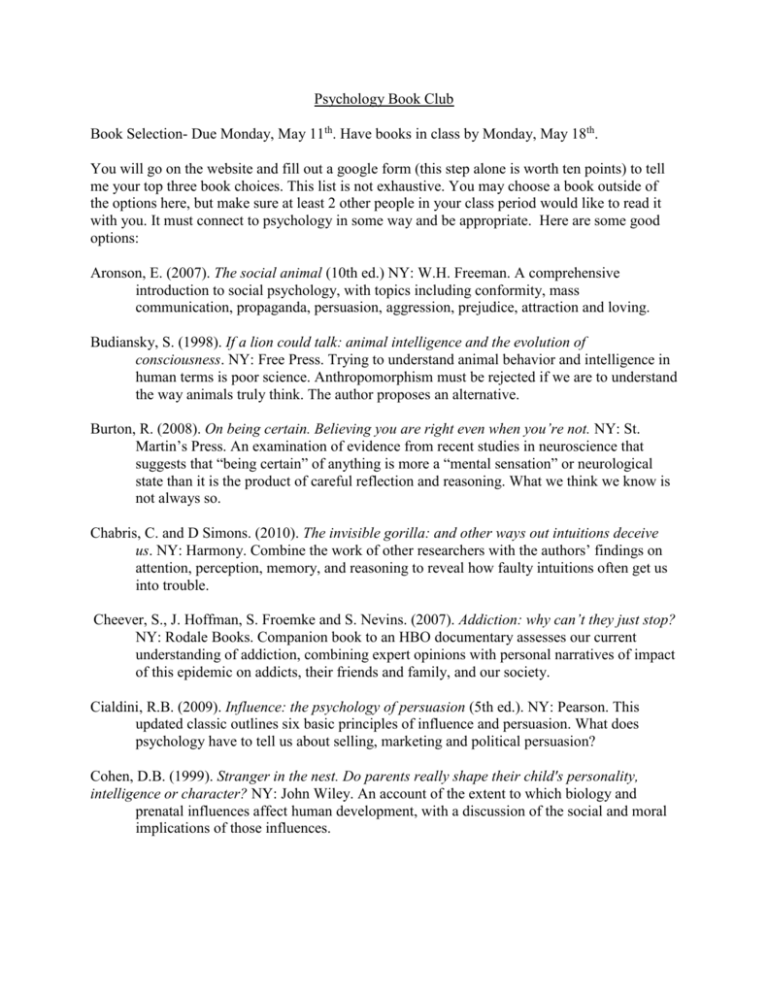
Psychology Book Club Book Selection- Due Monday, May 11th. Have books in class by Monday, May 18th. You will go on the website and fill out a google form (this step alone is worth ten points) to tell me your top three book choices. This list is not exhaustive. You may choose a book outside of the options here, but make sure at least 2 other people in your class period would like to read it with you. It must connect to psychology in some way and be appropriate. Here are some good options: Aronson, E. (2007). The social animal (10th ed.) NY: W.H. Freeman. A comprehensive introduction to social psychology, with topics including conformity, mass communication, propaganda, persuasion, aggression, prejudice, attraction and loving. Budiansky, S. (1998). If a lion could talk: animal intelligence and the evolution of consciousness. NY: Free Press. Trying to understand animal behavior and intelligence in human terms is poor science. Anthropomorphism must be rejected if we are to understand the way animals truly think. The author proposes an alternative. Burton, R. (2008). On being certain. Believing you are right even when you’re not. NY: St. Martin’s Press. An examination of evidence from recent studies in neuroscience that suggests that “being certain” of anything is more a “mental sensation” or neurological state than it is the product of careful reflection and reasoning. What we think we know is not always so. Chabris, C. and D Simons. (2010). The invisible gorilla: and other ways out intuitions deceive us. NY: Harmony. Combine the work of other researchers with the authors’ findings on attention, perception, memory, and reasoning to reveal how faulty intuitions often get us into trouble. Cheever, S., J. Hoffman, S. Froemke and S. Nevins. (2007). Addiction: why can’t they just stop? NY: Rodale Books. Companion book to an HBO documentary assesses our current understanding of addiction, combining expert opinions with personal narratives of impact of this epidemic on addicts, their friends and family, and our society. Cialdini, R.B. (2009). Influence: the psychology of persuasion (5th ed.). NY: Pearson. This updated classic outlines six basic principles of influence and persuasion. What does psychology have to tell us about selling, marketing and political persuasion? Cohen, D.B. (1999). Stranger in the nest. Do parents really shape their child's personality, intelligence or character? NY: John Wiley. An account of the extent to which biology and prenatal influences affect human development, with a discussion of the social and moral implications of those influences. Gay, P. (1998). Freud: a life for our time. NY: W.W. Norton. Seminal biography examines Freud's life in the context of Victorian culture. Although lengthy, if you are interested in European history, this is a wonderful study of how psychoanalysis developed to become one of the most influential. Hilts, P.J. (1995). Memory's ghost: The strange tale of Mr. M. and the nature of memory. NY: Simon & Schuster. Henry M. underwent experimental brain surgery in 1953 and has since lived only in the present. He can talk and read and write, but has no memory for what has just happened -- every minute is a new experience for him. Hobson, J.A. (2002). Dreaming An introduction to the science of sleep. NY: Oxford University Press. Recent work by one of the foremost experts on sleep and the emergence of dreams. Jamison, K.R. (1995). An unquiet mind. NY: Knopf. A beautifully written account of manic bipolar disorder (manic depression) written by a professor of psychiatry who is a victim of the disorder. A central theme is her reluctance to take the drug lithium even though it will be beneficial because she is afraid to lose the creative energy that comes with the disorder. Jourdan, R. (1997). Music, the brain and ecstasy: how music captures our imagination. NY: William Morrow. What is music, how does it affect us, and what accounts for musical genius? Are there any musicians out there? Kerr, J.H. (2006). Rethinking violence and aggression in sport. London: Routledge. Applies current theory of aggression to sport, inter alia how players become acclimatized to physical violence, the psychological benefits of sport violence, the problem of spectator aggression and the moral and ethical dimensions of the issue. Kubler-Ross, E. (1969, 1978). On death and dying. NY: MacMillan. Classic study of terminally ill patients and their adjustment, first elaborated “DABDA” stages of denial, anger, bargaining, depression and acceptance. LeDoux, J. (2002). Synaptic self: How our brains become who we are. NY: Penguins Books. Synthesis of recent research in neuroscience to explain how the interactions between nerve cells in the brain creates what we experience as personality. Livingstone, M.S. (2002). Vision and art: the biology of seeing. NY: Harry N. Abrams. Explains how artists use elements like perspective, luminance, color mixing, shading and chiaroscuro produce certain effects. A Harvard neurobiologist, the author discusses da Vinci's use of contrast, the illusory three-dimensionality of Impressionist paintings and why Mondrian's Broadway Boogie Woogie gives the impression of motion. Myers, D.G. (2004). Intuition: its powers and perils. New Haven: Yale University Press. The book builds on discoveries in cognitive science to explore the concept of intuition, its general strengths and weaknesses, and its relationship to investment, psychotherapy, and employment settings. Rothenberg, A. (1990). Creativity and madness: new findings and old stereotypes. Baltimore: Johns Hopkins University Press. Interesting but somewhat dated examination of the relationship between creativity and mental illness including consideration of Sylvia Plath, August Strindberg, Emily Dickinson, Robert Penn Warren, John Cheever, Eugene O'Neill and William Faulkner among other Pinker, S. (1997). How the mind works. Well-known M.I.T. cognitive psychologist offers a wideranging discussion of how we process information. Fascinating stuff! Dolnick, E. (2008). The Forger’s Spell. A true story about art forgery, the Nazis and the greatest art hoax of the 20th century. Fallon, J. (2014). The Psychopath Inside: A Neuroscientist's Personal Journey into the Dark Side of the Brain. Is author Fallon a law-abiding research scientist and family man or a dangerous psychopath? In this memoir-meets-pop-sci examination of psychopathy, Fallon discovers, to his initial surprise, that he has brain functions similar to a cohort of hardened criminals. Larsen, E. (2004). The Devil in the White City: Murder, Magic, and Madness at the Fair that Changed America Author Erik Larson imbues the incredible events surrounding the 1893 Chicago World's Fair with such drama that readers may find themselves checking the book's categorization to be sure that The Devil in the White City is not, in fact, a highly imaginative novel. Larson tells the stories of two men: Daniel H. Burnham, the architect responsible for the fair's construction, and H.H. Holmes, a serial killer masquerading as a charming doctor. Kesey, K. (1962). One Flew Over the Cuckoo’s Nest. Set in an Oregon psychiatric hospital the narrative serves as a study of the institutional processes and the human mind as well as a critique of behaviorism and a celebration of humanistic principles.
